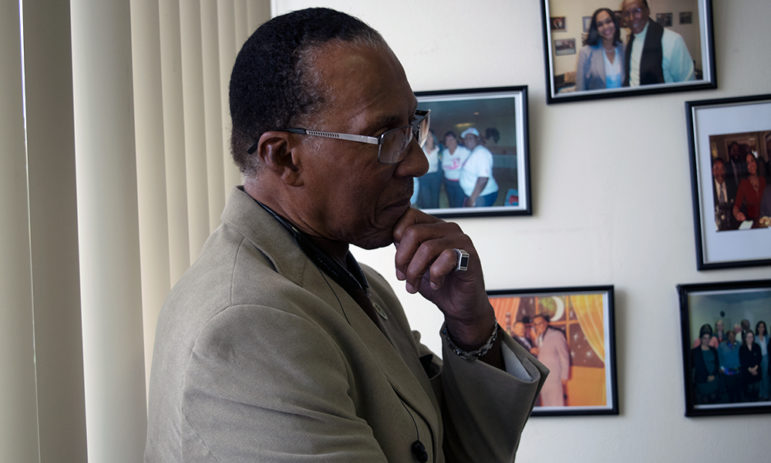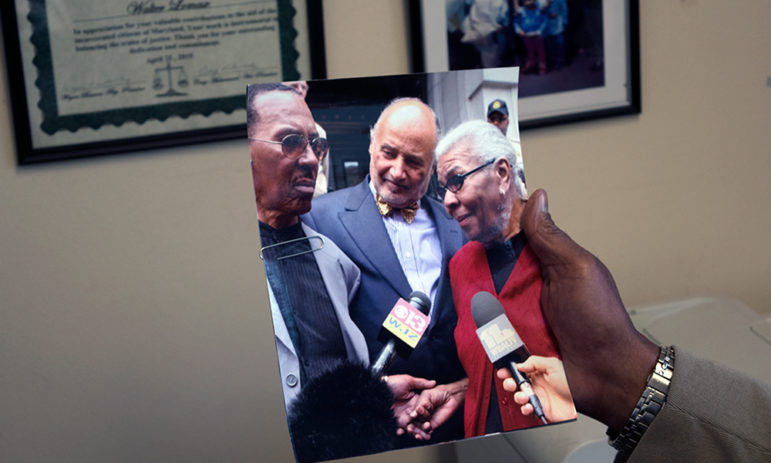By Julie Depenbrock
Capital News Service
They called him Mandela.
Some inmates knew it was a nickname. Some didn’t. Either way, it didn’t matter much to Walter Lomax. He appreciated the comparison.
He was a stern man — a writer. And like the late, long-incarcerated man who became South Africa’s first black president, Lomax had been imprisoned for life unjustly.
By the time he was released in 2006 after serving nearly 40 years for a murder he did not commit, Lomax had taken Mandela as his middle name. Two years later, he published “Mandela Conquers the Cut: Essays from Prison.”
Though he was transferred to and from many detention centers, Lomax spent much of his time behind bars at the Maryland House of Correction for Men, nicknamed “The Cut.”
Located in Jessup, Maryland, The Cut was a notoriously violent place. An almost Dickensian prison, opened in 1879, The Cut was so-called for its closeness to the path of the B&O Railroad. As the prison became more and more violent — with riots in the ‘40s, ‘60s and ‘70s — the name gained new meaning. In 2007, then-Gov. Martin O’Malley closed the doors of The Cut after the death of a correctional officer.
Lomax told the University of Maryland’s Capital News Service that even before then, the maximum security prison had been listed as “one of the most dangerous places in the country to be incarcerated.”
“My incarceration was a really tragic and horrible experience,” he said.
Those first 10 years, Lomax spent in a “state of suspended animation,” he wrote in “Mandela Conquers the Cut.” He kept expecting someone to notice his innocence, but no one did. He went “from outright disappointment to almost complete madness.”
It was only after that first decade he began to work.
Wrongly incarcerated from ages 20 to 59, Lomax taught himself to read and write, and eventually became editor of The Cut’s monthly magazine — “The Conqueror.”
“I wasn’t politically connected,” Lomax said. “My family didn’t have any funds, and so I realized the only way I was going to get out of prison was: I was going to get myself out of prison.”

Walter Lomax. Photo by Julie Depenbrock, Capital News Service
The long redemption
In 1967, Lomax was arrested for the murder of Robert Brewer, the night manager of Giles Food Market in Baltimore — a white man.
Lomax’s trial, which occurred in the months after the assassination of Martin Luther King Jr. and the ensuing riots on the streets of Baltimore, resulted in a guilty verdict from the all-white jury.
Five witnesses had identified Lomax — a young, black male — as the killer. Though his hand was in a cast that would have made firing a gun nearly impossible, and no physical evidence was found to connect him to the murder, Lomax was sentenced to life in prison.
Repeatedly, he petitioned for a new trial — and repeatedly, he was denied.
Then, in the mid 1990s, Centurion, a nonprofit dedicated to “vindication of the wrongly convicted,” started looking into Lomax’s claim of innocence.
Baltimore attorneys, Booth Ripke and Larry Nathans, represented Lomax as he filed a motion to reopen his case and alter his sentence.
Their post conviction petition alleged that Lomax had been represented by incompetent counsel and focused on the problems of proof, as well as a cross-racial identification.
What really happened
This is what really happened, the attorneys said:
About a week before Brewer’s murder, Lomax was chaperoning his sisters at a YMCA dance in Baltimore and was attacked by a group of teenagers. “Lomax was stabbed in his right hand so hard that the knife fractured a bone,” according to the National Registry of Exonerations, which has kept records of every exoneration in the U.S. since 1989. “He was kicked repeatedly and suffered bruised ribs and had difficulty walking for the next two weeks.”
Just hours before the shooting on Dec. 2, 1967, Lomax had a 15-layer plastic splint put on his right hand, “rendering the hand immobile,” according to Centurion.
While he was recovering, he lived with his older sister, who took care of him.
Lomax was subsequently arrested after three witnesses picked him out of an en masse line-up.
On Dec. 13, 2006, Baltimore City Circuit Court Judge Gale Rasin sentenced Lomax to “life suspend all but time served with probation.” He was free, though the convictions of attempted robbery and murder remained on his record.
Rasin acknowledged the strides Lomax had made behind bars. Illiterate when he entered prison, Lomax had not only learned to read and write — he’d gone on to earn his GED and associate’s degree. He took creative writing classes, tutored fellow inmates, and almost single handedly put together the prison’s monthly magazine.
“He became the prisoner poet, then the probationer poet,” Rasin said. “And now he will just be the poet.”
Clarinda Harriss, an English professor at Towson University, came to know Lomax as the prisoner poet in the ‘70s when the two began exchanging letters. Together, she and Lomax formed a “kind of two-person writing workshop.”
“He was clearly exceptionally intelligent and talented,” Harriss said. “Totally self-taught.”
On the day of his release, Rasin quoted a poem called “The Summer Day” by Mary Oliver: “Tell me, what is it you plan to do with your one wild and precious life?”
Harriss was in the courtroom for the next hearing. She remembers her friend Lomax telling the judge: “Your honor, when I looked up the poem you quoted … I felt kind of funny. It was about a grasshopper. But it was beautiful, and it was about what you do with your life, and here it is.”
Restorative justice
In 2009, a new state law granted defendants with new evidence the right to request court hearings — and three years later, Baltimore’s then-State’s Attorney Gregg Bernstein established a unit dedicated to investigating the cases of those who claimed they were convicted in error.
Lomax’s attorneys requested that this Conviction Integrity Unit take a look at his case.
They presented “newly discovered evidence,” including that a composite sketch was made of a suspect based on the descriptions of four eyewitnesses. Also included was a police report from an eyewitness to the robbery and murder. That witness, who looked through many mugshots, did not make a positive identification of the gunman, but did choose a “look-a-like,” according to the report.
Neither the composite sketch nor the police report was provided to Lomax’s original defense.
Another piece of evidence that was not disclosed in the trial was an interview with a woman — Peggy Jean Barnette — who said she heard gunfire and saw a man emerge from an alleyway “carrying a bag in one hand and his other hand in his coat pocket,” according to court documents.
“Ms. Barnette gave a description of the individual she saw, which was significantly different from the physical characteristics of Petitioner with respect to age, skin tone, and clothing,” Bernstein wrote. “Further, the individual’s ability to run away sharply contradicted Petitioner’s physical state at this time…”
“Thus, in the unique situation here in which the only evidence of Petitioner’s guilt consisted of cross-racial identification, the ability to have challenged the accuracy of this type of eyewitness identification creates a substantial or significant possibility that the outcome of the trial would have been different,” Bernstein continued.
In April 2014, Lomax’s convictions were vacated. The prosecution dismissed all charges.
The person who murdered Robert Brewer that night in December — 50 years ago — has never been found.
Work
Lomax turned 70 at the end of November and has aged gracefully. He’s fit and wiry, with a few gray hairs here and there. Inside his office at the Maryland Restorative Justice Initiative, he wears glasses, a tan suit, and a few assorted items of jewelry — a necklace and a ring on his pinky. He doesn’t talk much about those years in prison — two-thirds of his life.
“I have not yet completely come to grips with that,” Lomax says. “And it may be one of the reasons why I stay so focused and so involved in the work I do.”
When he was released, Lomax knew he wouldn’t be able to get a job with his convictions intact. So he decided to continue the work he’d started in prison. In response to then-Gov. Parris Glendening’s 1995 declaration that “life means life” — which effectively ended the possibility of parole for anyone with a life sentence — Lomax and others at the Maryland House of Correction formed the Lifers’ Coalition. Now, that organization, which Lomax directs, is known as the Maryland Restorative Justice Initiative. The nonprofit works to defend the rights of parole-eligible prisoners — particularly those serving life sentences.
Together with the Justice Policy Institute, a national nonprofit focused on justice reform, Lomax’s organization produced a documentary called “Blocking the Exit,” which focuses on those serving life sentences, as well as victims and their families.
Sen. Kelley helps
Lomax’s nonprofit has most recently supported legislation that eases the compensation process for those who’ve been exonerated — under the sponsorship of Maryland Sen. Delores Kelley, a Baltimore County Democrat. Lomax serves with Kelley on a 10-person task force to address erroneous conviction and imprisonment.
The panel, whose meeting last week was postponed by the governor’s office, is charged with making recommendations for a compensation standard before the end of the year.
“The formula will end up making it more likely that we can get something done, so these people aren’t without anything,” Kelley said in an interview.
It was because of Lomax that Kelley fought to get a new law passed last session — one that would allow exonerees to bypass a pardon and get compensation from the state.
Exoneration, which is not a legal term, “occurs when a person who has been convicted of a crime is officially cleared based on new evidence of innocence,” according to the National Registry of Exonerations. Under Maryland law, a pardon is defined as an “act of clemency” from the governor.
Previously barred from compensation because he’d not yet received a pardon, Lomax is in the process of submitting a request to Maryland’s Board of Public Works.
“Mr. Lomax has served 39 years,” Kelley said. “He’s 70. To have him pass on to the great beyond with nothing — if we could do something — is something we have to consider.”
Harriss, who later became Lomax’s editor at BrickHouse Books, said most people in Lomax’s situation would be outraged. She recalled when Lomax visited her classes at Towson University. One student said Lomax seemed almost “inhuman.”
“She meant that his lack of bitterness seemed beyond human capability,” Harriss said. “She was right about that.”
Life outside
At an age when most of his peers have retired, Lomax has thrown himself into his work. “It’s a 24/7 job,” he says. “I’m in here Saturdays and Sundays.”
When asked about what he does in his free time, he pauses a while.
“I like to read. Listen to music,” he says. “I work out.”
Though he’s never been married, he has family — a son and a daughter, eight grandchildren, 20 great-grandchildren, as well as countless nieces, nephews, grand-nieces and grand-nephews.
When all of them get together, they just barely fit into a picture frame.
For decades, Lomax’s family has contended his innocence.
“When I was arrested and incarcerated, the people who believed the most in my innocence were the women in my life — my mother and sisters. These were the people who understood me and knew that I was not capable of committing such crimes,” Lomax wrote in his book. Lomax said these women helped shape his character and the way he views the world and treats people.
“My brother’s been gone so long. I just thank God that he’s back with us and that he’s still in his right mind,” said Audrey Lomax Brice. “To be incarcerated so long and come back so strong. … We’re just trying to make up for the lost time. Just shower him with love.”
In Lomax’s Baltimore office, every picture on the wall has a meaning — a memory. There are photos of Judge Rasin, of family members, political figures. Michelle and Barack Obama have a place and, of course, so does Nelson Mandela. A portrait of Lomax’s chosen namesake rests dead-center on the cream-colored wall.
But perhaps Lomax’s dearest possession is a framed photo of him and his sister, Carolyn Lomax, taken the day he was exonerated in 2014. The two siblings are together — and they are clasping hands.
Carolyn Lomax, called “Lady C” by her family, passed away two years later.

Walter Lomax holds a 2014 photo of him and his sister from the day he was exonerated. Attirbey Billy Murphy is in the background. Photo by Julie Depenbrock, Capital News Service
Scars
In Maryland, 33 people have been exonerated — and of those 33, only five have been compensated by the state.
Lomax meets with other Marylanders who’ve been wrongly imprisoned — people like Michael Austin, Kirk Bloodsworth, and Leslie Vass.
Vass, who served 10 years for armed robbery and was pardoned in 1986, got to know Lomax while they were both behind bars. They were in the Maryland Penitentiary together back in 1975, Vass said.
“At the time of my conviction, I was 17. Walter was already inside the institution,” Vass said. “He had a lot to do with motivating me to continue my education.”
When they were imprisoned in Hagerstown, they began working on their cases together through a legal clinic.
The two remain good friends.
“We relate on a level that no one else who hasn’t had that experience can relate to,” Lomax says. “You know that you’re talking to someone who can understand what you’re feeling, what it is you’re going through.”
He stops, his eyes glazed in the half-light of this afternoon in northeast Baltimore.
“People will look at a person. On the outside, they look healthy. Psychologically, they seem sound. But after you’ve had that experience, you will never be the same person,” Lomax says. “You will never be the same as before. Because you weren’t able to develop naturally and unfold, as people do. Grow and mature, as they do. You just have that psychological scar that will be there for the remainder of your life, knowing that.”




Recent Comments